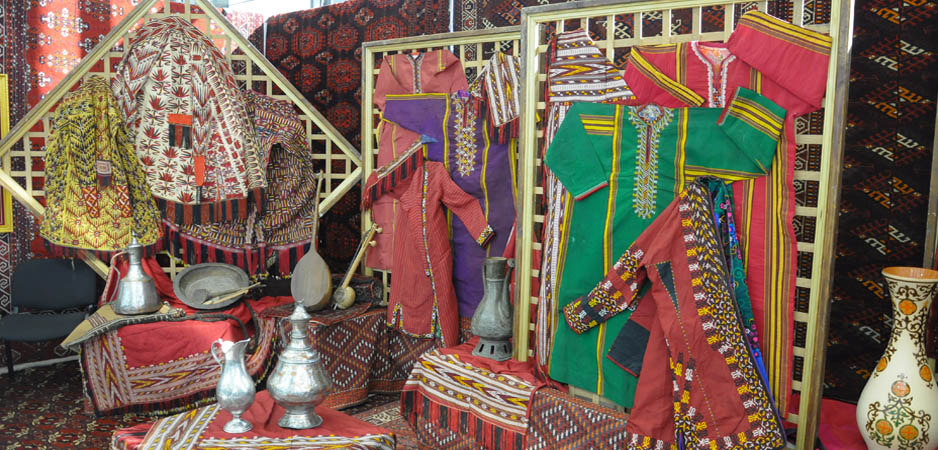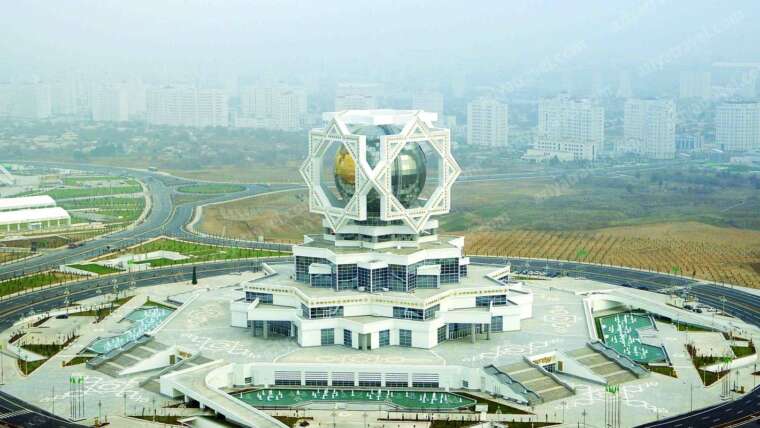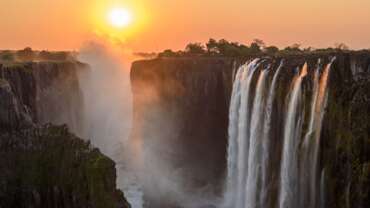Turkmenistan - the heart of the Great Silk Road!
An ancient cultural crossroads blessed with rich cultures, ruined cities and dramatic landscapes, Turkmenistan is Central Asia’s least visited and most mysterious nation.
It was across these remote lands that nomadic empires, ancient conquerors and Silk Road traders traversed, leaving behind a rich cultural and archaeological legacy.
Explore incredible ancient ruins at the sprawling archaeological site of Merv, once a major oasis city along the famous Silk Road trading route; and marvel at the haunting landscapes of the Karakum Desert.
Adventure tourism in Turkmenistan is a discovery of some of the most unusual natural marvels of Central Asia, each of which reflects the country’s unique personality and holds the promise of an experience wholly unlike any you’ve encountered before.
Race through wild foothills on one of Turkmenistan’s world-famous Akhal-Teke horses, akin to the Ferrari of the equestrian world. Zigzag through the country on an unforgettable overnight train ride. Uncover dunes and remote settlements as your intrepid local guide introduces you to the best of Turkmenistan.
Camp on a cliff in the breathtakingly gorgeous Yangykala Canyon, whose multihued formations are likened to the Grand Canyon (minus the crowds). Sleep under the stars near Koytendag State Nature Reserve in eastern Turkmenistan, famed for its mysterious collection of footprints known as Dinosaur Plateau, or hike the ridges of the Kopet Dag Range just a few kilometers from the border with Iran.
Your Turkmenistan tour could take you off-roading for days through the expansive Karakum Desert, one of the hottest destinations on the planet, where you’ll likely see far more scrubby camels than fellow human beings. Within the desert’s sultry confines is Darvaza Gas Crater, a gaping man-made cavity whose underground natural gas reserves have been continually burning since 1971. Photos fail to do justice to this phenomenon, which is best appreciated under the pitch-black sky on an overnight camping experience. Then there’s Dekhistan, the ruins of a former oasis town now considered the most isolated ‘city’ in Turkmenistan and another great desert camping spot.
Despite its predominantly desert terrain, we offer aquatic attractions in the unlikeliest of places. Go for a dip in the underground sulfuric waters of Kow-Ata Lake, whose naturally warm waters are purported to have healing properties. Hike through mountains to discover waterfalls or the renowned Kainar Baba Lake in southern Turkmenistan, whose glistening droplets are a source of drinking water for the region. And of course, the Caspian Sea coast along the western border offers days of swimming, sunbathing and exploration, a well-earned reward for having traversed the country’s rugged interior landscape.
We can even take you beyond the country’s jagged confines on a dual Uzbekistan-Turkmenistan tour, where crossing the border is often an adventure in itself.
Head to the laidback capital of Ashgabat to explore mosques, museums and monuments, as well as the Palace of Turkmenbashi and the nearby ancient ruins of Nisa, one of the earliest and most important cities of the Parthian Empire.
Engage with rich local cultures; trawl colourful markets for vibrant carpets and handicrafts; and enjoy the famous hospitality of some of the friendliest people you’ll ever meet.
Take a look at our Central Asia Journey or Tashkent to Isfahan adventures to get a taste of this isolated gem of Central Asia.
History of Turkmenistan
Early civilization and arrival of the Turkmens
It is possible to follow the development of human habitats in southern Turkmenistan from Paleolithic times to the present. Some of the earliest traces of agriculture in Central Asia were discovered some 20 miles (32 km) north of Ashgabat in the Neolithic Jeitun civilization, which may be dated to the 5th millennium BCE. The Jeitun civilization was followed by a series of other Neolithic cultures, and a cultural unification of southern Turkmenistan occurred in the Early Bronze Age (2500–2000 BCE).
During the course of the following half millennium, some urban centres were created; the ruins of Namazga-Tepe cover approximately 145 acres (60 hectares). From about the mid-3rd century BCE to the Sāsānian conquest in the 4th century CE, Turkmenistan formed part of the Parthian empire (see Parthia).
Into this land came, probably in the 11th century, the Turkmens, strangers, as it were, with no links to any previous civilization of the region. Contemporary historians did not distinguish them from the Oghuz, a loose confederation of Turkic tribes present in the region since the 9th century. Turkmens came under the rule of the Seljuq dynasty (1038–1194) of Oghuz tribes, and they weathered the Mongol invasions (13th century) quite well; the southern tribes became part of the Il-Khanid empire, and the northern tribes belonged to the Golden Horde. One of the Turkmens’ principal occupations for centuries after the decline of Mongol rule was robbing passing caravans.
Turkmen tribes and Russian invasion
Until 1924 the Turkmens never experienced even nominal political unity. Their organization was exclusively tribal, and the tribes were either nomadic and independent or subject to neighbouring Persia or to the khanates of Khiva and Bukhara. During the 16th and 17th centuries the Chaudor tribe led a powerful tribal union in the north, while the Salor tribe was dominant in the south. During the 17th and 18th centuries the ascendancy passed to the Yomuts, Tekkes, Ersaris, and Saryks, who began to move out of the desert into the oases of Khorezm and to the Atrek, Tejen, and Morghāb rivers and to adopt a settled way of life.
There was bitter rivalry among the tribes, particularly between the Tekke and Yomut, while the Goklans, inhabiting part of the Khiva oasis, were opposed to both. Thus, while the Tekkes were the principal opponents of the Russian invasion in the 1860s and ’70s, the other tribes either failed to support them or helped the Russians.
People of Turkmenistan
Ethnic groups
For centuries the Turkmens were divided into numerous tribes and clans, the largest being the Tekke, Ersari, and Yomut. Prior to the Russian Revolution most of the Turkmens were pastoral nomads, though during the 18th and 19th centuries many had settled in the oases and become agriculturalists. Their tribal organizations and loyalties were strong, and they often hired themselves out as mercenaries to various rulers in Central Asia and Iran. Turkmenistan’s incorporation into the Soviet Union had the effect of bringing greater unity to the Turkmen tribes and of giving them the beginning of a sense of nationhood.
Turkmens make up more than four-fifths of the republic’s population, up from three-fourths at the end of the 20th century and about two-thirds in 1970, largely because of a relatively high birth rate. There are smaller numbers of Russians, Uzbeks, Kazakhs, and Tatars.
Language
The Turkmens speak a language belonging to the southwestern, or Oğuz, branch of the Turkic linguistic group. As such, Turkmen is more closely related to Turkish than it is to either Uzbek or Kazakh. Since 1993 it has been written in the Latin script. Russian is the primary language of nearly one-eighth of the population and is widely spoken as a second language, but its use has declined significantly since independence.
Religion
The vast majority of people in Turkmenistan are Muslim, mostly Sunni of the Ḥanafī school. Islam among the Turkmens has a notable tradition of being tempered and infused with folk practices and traditions. The government promotes secularism and keeps tight control over senior Muslim clergy in the country, and more fundamentalist interpretations of Islam are suppressed. The second largest religion is Russian Orthodox.
Art & Culture of Turkmenistan
The arts
The widespread Turkmen traditional practice of composing poetry orally gave way, after printing became well established in Turkmen centres in the 1920s, to writing and to the dissemination of verse and prose in book form. Although written Turkmen literature dates at least to the 18th-century poet Mahtum Quli (Magtim Guli), it underwent a burst of growth when the literary publications of the new republic began to appear in the late 1920s and ’30s. Outstanding graduates of Bukharan seminaries such as Abdulhekim Qulmuhammed-oghli (died c. 1937) brought about a renewal of intellectual and cultural life in Soviet Turkmenistan. Qulmuhammed-oghli served in the anti-Soviet Basmachi resistance movement, later became a communist nationalist, and influenced younger intellectuals through his activities as a writer, editor, researcher, and cultural organizer.
All such efforts came to an end in the 1930s when the purges instigated by Soviet leader Joseph Stalin and carried out locally by Russian and Turkmen communists destroyed this small core of outstanding intellectual leaders, including Qulmuhammed-oghli. After that, Soviet-educated intellectuals dominated cultural life. Among these figures, Berdi Kerbabayev attained some renown for his novel Aygïtlï ädim (1940; The Decisive Step) and a later novel, Nebit-Dag (1957), as well as plays, poems, and translations.
Cultural Life
Daily life and social customs
Turkmen cuisine shares much in common with other cuisines of the region yet is markedly set apart by its nomadic tradition and geography. One of the most popular dishes is ash, a rice and meat pilaf not unlike those of other cuisines in Central Asia. Meat and dairy play a heavy role in Turkmen cuisine, particularly fatty mutton and sheep’s milk. A variety of dishes involving fish are also common in the Western part of the country near the Caspian Sea. Spices are used sparingly; Turkmen cooking aims instead to preserve the ingredients’ flavours.
Some public holidays reflect Turkmenistan’s cultural milieu, while others centre on national events. Like many countries in the region, Turkmenistan celebrates the spring festival of Nōrūz. The Islamic holidays of Eid al-Fitr and Eid al-Adha are likewise observed as public holidays. A day of remembrance is held on October 6 to pay respects to the victims of the devastating 1948 earthquake in Ashgabat.
One Country. Many Faces
At present, Turkmenistan created opportunities for scientific study, preservation and promotion of our ancestors passed down from spiritual and cultural values, national heritage and a rich historical past. A clear evidence of this is the declaration of 2016 in Turkmenistan “Year of honoring the heritage, the transformation of the Motherland.”
Turkmenistan is the center of the ancient architectural structures such as Kunyaurgench, Merv, Nisa, Mashhad-Messarian, Abiverd, Amul, Gonurdepe, Parzdepe, Silk Road, as well as our Akhal-Teke horses, magnificent carpets, traditional Turkmen wedding that attracts the attention of tourists from all over the world.
In addition, in the territory of Turkmenistan were built beautiful cities, built a complex of magnificent palaces, mosques, caravanserais, libraries, observatories.
Turkmenistan is considered the cradle of early civilization, which had a significant impact of the evolution of world civilization. History of Turkmenistan originates from ancient times, and extends along the route of the Silk Road, which was of great importance to maintaining and strengthening the economic and trade relations and cultural relations with many countries of the world.
Increased interest of historians, experts in the study of heritage tourists to the rich historical, cultural and archaeological heritage of Turkmenistan. During the year, in Turkmenistan held a variety of international scientific-practical conference devoted to the study and promotion of the cultural heritage of the Turkmen people and national values.
In this regard, there are all necessary conditions for the organization and holding of international conferences to facilitate the further development of the tourism industry of the country.










